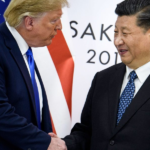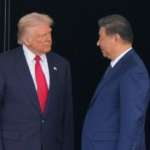Economists have suggested the development can be framed in two ways. Firstly, the Trump administration may merely be clearing up its own self-conflicted chaos, or this may signal a push within the White House towards deescalating tensions with major trading partners.
This, in turn, could offer hope to trade partners such as the EU which are still working on ways to reach common ground with the Oval Office.
Whatever the reasoning, markets are bouncing even on the temporary reprieve of a near-three month window for further negotiations between the world’s two largest economies to take place.
At the time of writing the U.K.’s FTSE 100 is up 0.4% while the Nikkei 225 rose 0.4% for the day.
“There is a thread that’s trying to create a set of norms and a set of ideas underpinning the actions that have been taken,” she explained but added: “I think it’s very important though—if I’m in Brussels or elsewhere—to keep in mind that this is very retroactive … that the chaos has already been unleashed.
“What Bessent is doing is cleaning up the mess, and it’s a really important clean-up and it’s an indication that there is a willingness on the part of both the United States and China to negotiate.”
While Treasury Secretary Bessent represents the side of negotiation, there remain some hardline tariff fans within the White House, added Ingleson: “There are others … who do take a very different approach to the the way in which trade and the United States’s place in the world should operate, and that isn’t going away yet.”
To briefly recap, President Trump’s economic sanctions on China began early into his term with a 10% tariff on the nation to address his concerns about fentanyl flowing from the China into the U.S. This was then bumped up to 20% a little over a month later.
Both sides have now agreed to lower their rates by 115% for the next 90 days, meaning Bejing faces a 30% tariff and the U.S. faces a 10% tariff.
With uncertainty rife in the market since Trump took the Oval Office—and with foreign policy changing so rapidly—analysts are celebrating the news as a short-term relief as opposed to a longer term, certain shift in the outlook.
“This is clearly just the start of a broader and more comprehensive negotiations, and we would expect both these tariff numbers to move down markedly over the coming months as deal talks progress,” wrote Wedbush analyst Daniel Ives in a note seen by Fortune this morning. “With US/China clearly on an accelerated path for a broader deal we believe new highs for the market and tech stocks are now on the table in 2025 as investors will likely focus on the next steps in these trade discussions which will happen over the coming months.”
Trump’s tariff plan—particularly the “Liberation Day” update in early April which pushed import rates from China to more than 150%—prompted fears of a raft of unsavory economic outcomes.
JPMorgan’s Jamie Dimon, for example, feared that an ‘America first’ policy could push key military and economic allies into the arms of rivals, while others suggested the economic sanctions would choke business investment and stunt economic growth while also raising prices for consumers as business passed on the higher costs.
Stagflation fears (rising prices with weak economic growth) were mounting, but Bloomberg Economics said that the new rate on China means the average effective tariff rate on all U.S. imports is now 10.4 percentage points, down from 20.3 percentage points. As such, the ripple effects on GDP and inflation are more minimal, at a hit of 1.5% to growth and a bump of 0.9% to inflation.
Ives adds: “We also believe while supply chain and economic damage has been done by these onerous tariffs since Liberation Day…the Street will instead focus on normalized growth post this volatile six week period since April 2nd…and these massive tariff reductions at this time likely take a recession off the table for now in our view.”
“The magnitude of this tariff reduction is larger than expected,” writes Tai Hui, APAC chief market strategist at J.P. Morgan Asset Management. “This reflects both sides recognizing the economic reality that tariffs will hit global growth and negotiation is a better option going forward.
“The 90-day period may not be sufficient for the two sides to reach a detailed agreement, but it keeps the pressure on the negotiation process. We are still waiting for further details on other terms of this agreement, for example, whether China would relax on rare earth export restrictions.
“Overall, we expect the market to get back on to a risk-on sentiment in the near term. Pressure on the Fed to cut rates may also ease for the time being.”









